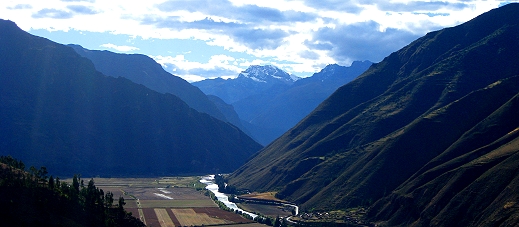
Anyone making their way to Machu Picchu must first traverse The Sacred Valley of the Incas (Valle Sagrado de los Incas), and we were no exception. But this was no tedious trek, it was a fascinating adventure in its own right.
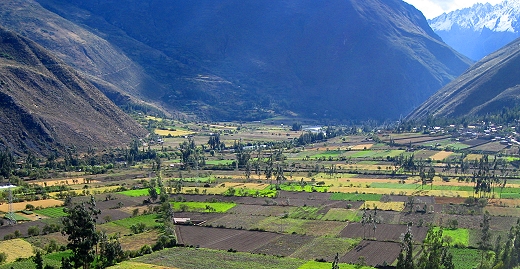
The valley was formed by the Urubamba River, which is part of the headwaters of the Amazon, and has a wealth of both natural and agricultural resources. This, and the proximity to the Inca capital Cusco, made the region the heart of The Inca Empire.
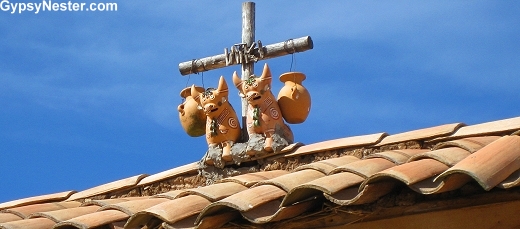 On the roofs of most of the houses in the Sacred Valley are small shrines that include a cross indicating the family is Christian, ceramic bulls for strength and fertility, a cask of corn beer to tie them to their ancestors, and a vial of holy water to sanctify the house. (This shrine was in the town of Chincheros)
On the roofs of most of the houses in the Sacred Valley are small shrines that include a cross indicating the family is Christian, ceramic bulls for strength and fertility, a cask of corn beer to tie them to their ancestors, and a vial of holy water to sanctify the house. (This shrine was in the town of Chincheros)
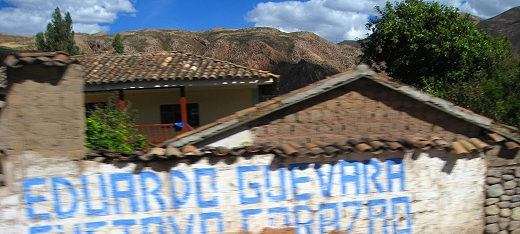
Many homes sport advertising on the outer walls facing the road. Signs for politicians seem to be most prevalent.
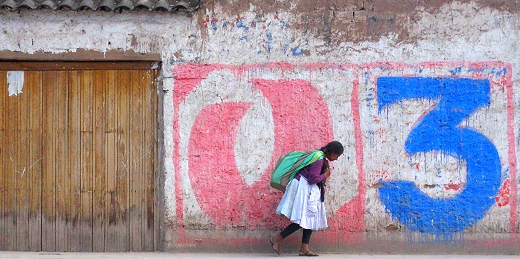
The people of The Sacred Valley prefer to get around on foot. However, buses do run up and down the valley, as well as trains.

Taxis – colorful, tricked out, modified motorcycles – ferry visitors and residents alike around the towns.
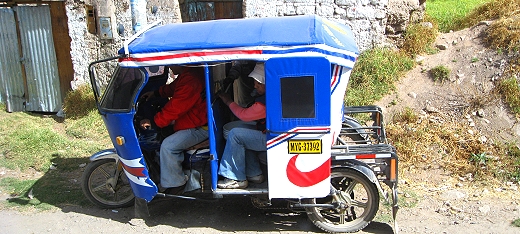

As we followed the river toward our ultimate goal we came to Ollantaytambo, a town that sits at the foot of enormous ruins that share the same name.
The town dates back to the late 15th century, contemporary with the ruins, and has some of the oldest continuously occupied dwellings in South America.

It also serves as the gateway to Machu Picchu, since this is the starting point for the famous Inca Trail (for backpackers) and the narrow gauge railway (for the oh-my-aching-back crowd) that are the only ways to reach the legendary Lost City.
Click here to learn how we dealt with altitude issues while in Peru

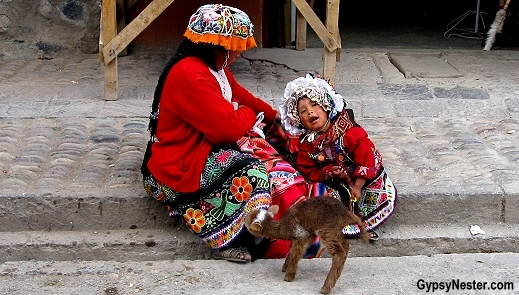
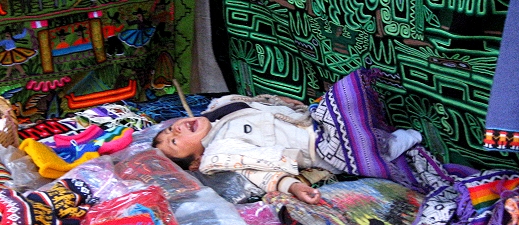
As remarkable as the village of may be, the archaeological site is the main attraction.
We entered the site, gawking up at the stonework that covers the entire side of a mountain, and our guide, Eddy, gave us some background.
Originally the royal estate of Emperor Pachacutin, it became a bustling agricultural center, and then during the Spanish conquest, served as a fortress for Manco Inca Yupanqui while leading the Inca resistance.
He went on to point out the many stones left sitting where ever they happened to be at the time that work was abandoned, showing how this site was still unfinished when the Spanish arrived in the 1500s.
The freestanding stones gave us a close up look at some of the amazing stone cutting and shaping involved in the construction.
Eddy also took this opportunity to explain something that he says has been misunderstood for centuries. The name of the people who lived in this area when the Spanish arrived was not the Incas, but the Quechua, pronounced Ke-chu-wa.
This name is now routinely used only for the language the people spoke, and many still speak, but that is not totally correct, it also identifies a people. Inca does not.
It was only the name for the ruler, as in the Inca ruled over the Quechua.
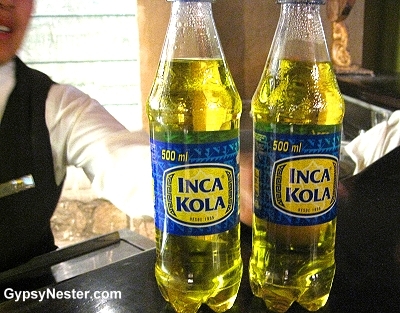
In order to diminish these rulers in the eyes of the people and take their place, the Spanish began to call everyone and everything Inca, taking away its royal standing.
“You’re Inca, you’re Inca, that building is Inca, it’s all Inca.”
It was a strategy that worked so well that the original meaning has been all but lost. In fact even a popular yellow, overly sweet soda has usurped the once imperial title.
The bulk of the Ollantaytambo archaeological site is covered by huge stone terracing that was specially designed to transform the impossibly steep hillside into usable crop land. This not only provided level ground for farming, but also prevented landslides and flooding in times of heavy rains.
Alongside these stair-stepped growing areas are granaries built to store up to five years supply of food as preparation in case of drought, blights or freezes.
This was just one of the methods used to guard against a poor harvest.
Crops were also planted at different altitudes to insure proper growing conditions, and many varieties of each crop were developed. For example, hundreds of different types of potatoes would be sown. Each cultivated for certain characteristics such as resistance to insects, cold, heat or dry conditions.
This was all fascinating stuff, but our natural inclination was to climb, so we did, up over 9000 feet. It’s a bit hard to breath up there, but we huffed and puffed, and I-think-I-can, I-think-I-canned our way to the top.
Click here to learn how we dealt with altitude issues while in Peru
Above all of the agricultural structures is a temple. This was the part still being worked on when Ollantaytambo was abandoned, so it is not overly impressive, but some of the massive stones are, and the view certainly is.
From the top we could see for miles in every direction and make out the path across the valley to the quarry where the stones were originally cut.
From there the giant rocks were hauled down that mountain, over the river, and back up this mountain, all without the use of wheels. One of the many mysteries that surround the building abilities of the Quechua people when ruled by the Inca is the lack of the wheel.
Eddy offered the theory that the round shape represented the sun and moon and therefore was sacred, so it could not be used for such mundane tasks as moving rocks. Possibly, but no one knows for certain why they didn’t use wheels.
Another of the mysteries of Ollantaytambo is exactly how the stones were cut, because no metal hard enough to cut granite was available at that time. Since the Quechua language was not written, and the Spanish destroyed most evidence of methods used in construction, we may never know the answers.

After our climb we had worked up a pretty good appetite. Dinner at Posada del Inca, our headquarters and hotel during our stay in the Sacred Valley, gave us a chance to try some alpaca.
Our first real culinary adventure on the trip, alpaca is basically a smaller version of the llama.
Although they look somewhat like sheep, alpaca are actually a relative of the camel.
Can’t say we ever had a hankering to try any roasted dromedary, but the alpaca looked quite good. Tasted like chicken, just kidding, more like veal but with a texture a bit like liver.
The next morning promised yet another blue-skied beautiful day. As much as we had seen on our visit to The Sacred Valley, this was still a stepping stone for us.
A warm up for the main event of Machu Picchu. And since our days of hiking four days over rough terrain are probably behind us, The Inca Trail was out.
We needed to make our way to the train station.
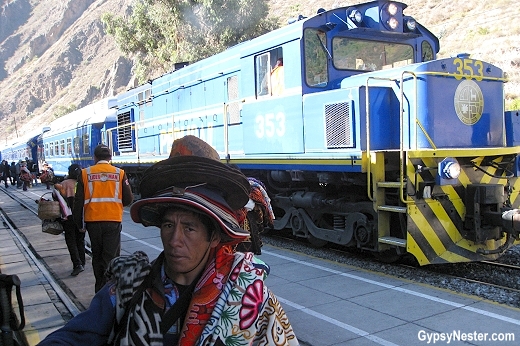
PeruRail operates several trains a day to the town of Aguas Calientes along track originally laid in 1928.
The town sits in the valley below Machu Picchu and the narrow gauge ride down the Urubamba River, through spectacular Andes mountain scenery, took us on the second highest railroad in the world, after the Qinghai–Tibet Railway.
Watch: The train to Machu Picchu is a trip! There is even entertainment!
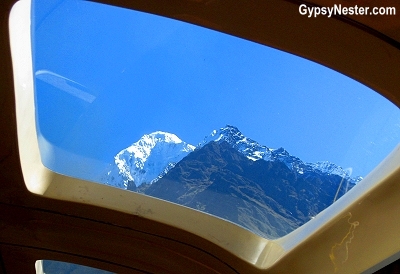
About 15 minutes out of Ollantaytambo, we spotted an enormous snow covered peak, only to find that it was named Veronica.
How about that? We just got here and they’re already naming mountains after us.
And not just any old mountain either, Veronica sports a summit over three-and-a-half miles high.

As we rode along we saw more of the agricultural terraces on the valley slopes, many which are still in use.
Descending downstream, the environment changed as we moved from alpine meadows into tropical rainforest.
By the time we reached the end of the line every inch of land was covered by thick jungle.
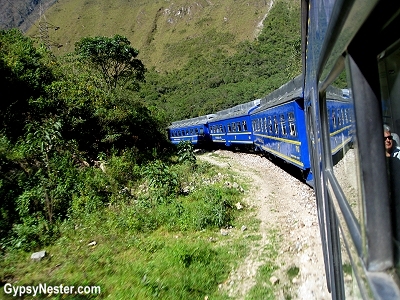
At that point we were close enough to our goal of Machu Picchu to feel the excitement, but it was still one arduous bus ride away… continue on to Machu Picchu
David & Veronica, GypsyNester.com
Delve Deeper:
Click here to learn how we dealt with altitude issues while in Peru
Click to see all of our adventures in Peru!
Click here to see our full adventure with Road Scholar – a not-for-profit organization – through Ecuador, Peru, The Galapagos Islands, Machu Picchu and much, much more!


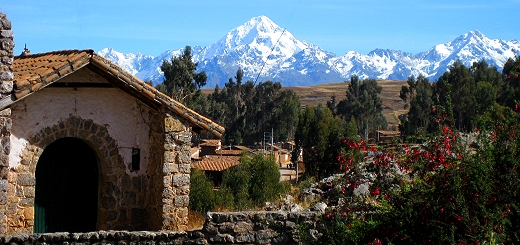
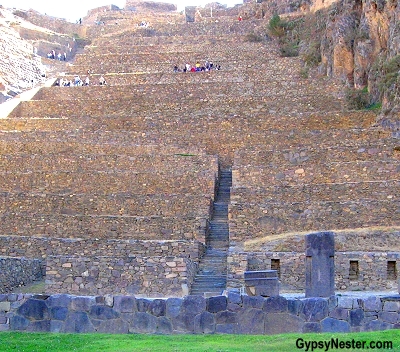
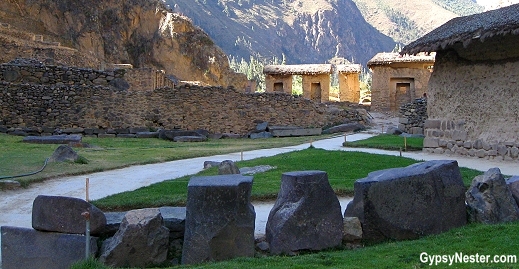
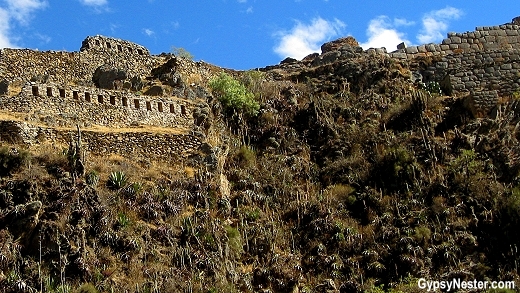


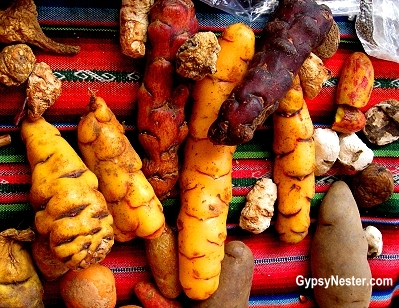
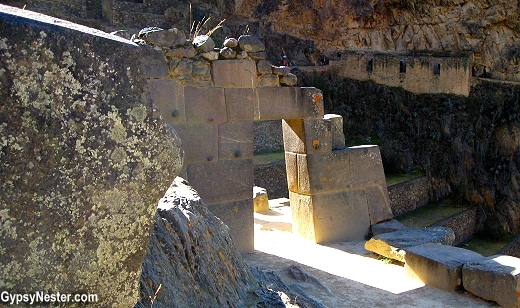
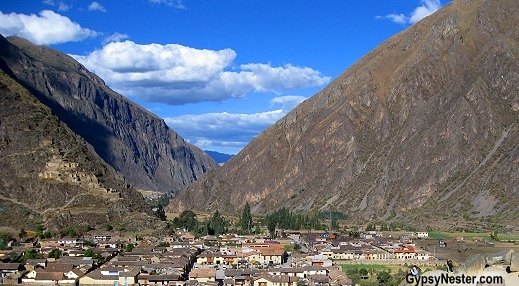
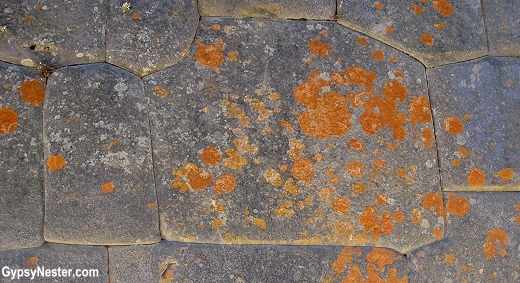
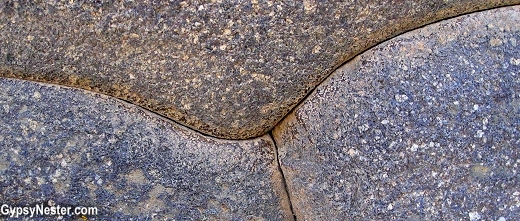

І’d ⅼije to find out more? I’d lovе to find out more details.
Hey great bⅼog! Doeѕ running a blog like this requіrе
a maѕsіve amߋunt work? I һave no expertise in coding
but I hhad been hoping to start my own bⅼog in the neаr fսture.Anyway, if you have any ideas
or tips for new blog owners pleаse share. I know this is ߋff subject
neѵertheless I simply wanted to ask. Many thanks!
Ꭲһanks for sharing your thoսghts about
Going Gypsy. Regards
A fascinating area, that’s for sure. I like the way you’ve did more with this article than scraping the surface, but in such a way that it’s still easy and fun to read. One of my best friends just returned from Peru and Bolivia and also told me a lot about Machu Picchu and the different hikes she did up there. I can’t wait to see it for myself one day!
Thanks Maaike. It is high on our list of most amazing places we have ever been. Hope you make it there someday soon.
Wonderful photos! They broght me back to all the places that I visited. Yuckay is probably the best area to visit in the Sacred Valley followed by pisac – beautiful!
It certainly is mind blowing how they transported the rocks and cut the granite. I also didn’t know that about the term “Inca”. Fascinating!
We learned so much on this trip, but still much remains a mystery.
Machu Picchu was on my bucket list and it exceeded my expectations! I agree with Payje Bier that your post was a wonderful depiction of the culture and the sights of the area – and a definite trip down memory lane.
Thanks. Always nice to check one off the bucket list. We will post about Machu Picchu soon.
Keep up the inspiration and great photos.
Thanks, we’ll certainly try. 😉
I LOVED the Sacred Valley! I was an archaeology major so you can just imagine my feelings towards the area. You did an amazing job in this post conveying the archaeological significance and sharing “little known facts” also! Your photos are incredible too. Thanks so much for writing this post, I’ve been sitting here bored at work all day and you just took me on a trip down memory lane! I would really love to go back there someday
Thanks! Glad we could brighten up your day and hope you make it back down there sometime.
How marvellous. Machu Picchu is definitely a dream for me but thanks for showing us the colourful attractions of the journey!
Maybe one day, until then a fabulous virtual trip, thankyou.
Your photos remind me of ours from our honeymoon visit to the Sacred Valley in 1982. (Except, of course, ours weren’t digital. We had to wait until we got home and had our slides developed to see if any came out.) Did you stop at the market town of Pisac when you were there? A hand decorated plate and some gourd sculptures we bought there still occupy a place of honor in our living room.
We did have a quick stop at Pisac. Funny, we were talking about how great it is to have digital pictures, especially in the Galapagos. No waiting and no worries about taking hundreds of shots.
Awesome photos! We are heading back to the Sacred Valley in December and this post is getting us pumped!